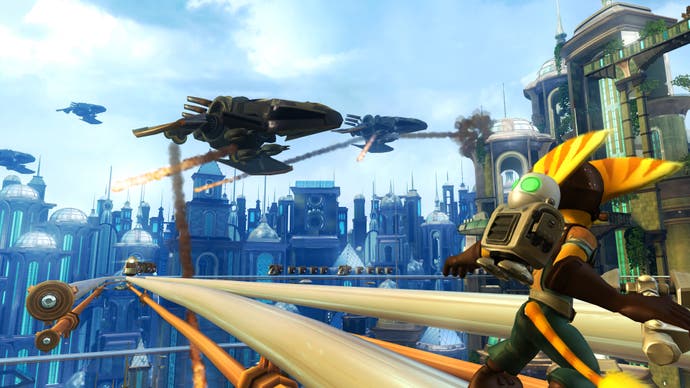Ratchet & Clank: Tools of Destruction
Triggers happy memories.
What's the most surprising thing about the first PS3 instalment in the Ratchet & Clank series? It's not the return to the classic platforming-shooting-collecting gameplay of the first three games. It's not, whatever the hype might say, because it's exactly like playing a Pixar film. Because it isn't, as even Insomniac will admit. It's this: Ratchet & Clank: Tools of Destruction makes use of the Sixaxis controller's motion-sensing capabilities in a way that isn't completely rubbish.
But first, let's look at Insomniac's decision to go back to Ratchet's roots, specifically those of the original games. The fourth instalment, Ratchet: Gladiator, focused on arena combat. This got the thumbs down from many fans, who saw the shift away from the series' traditional action-adventure gameplay as misguided, unnecessary and rubbish. Ratchet himself "went dark", which suited him no better than it did Jak, the Prince of Persia or Harold Bishop.
The good news is Ratchet's back to his jolly old self in the new game, as Insomniac's Ryan Schneider explains. "In Ratchet: Gladiator we took a turn for the dark side. He was a more sophisticated Ratchet. The fan feedback said they liked Ratchet the way he was, and so do we as developers. Ratchet's personality is more engaging when he's being that confident screwball."
Tools of Destruction's storyline goes even further back to Ratchet's roots. It will reveal more about where our hero came from, why he's the last surviving lombax in the galaxy and, hopefully, what the flip a lombax is anyway.
Back to the future

But the real return to form comes with the gameplay. Tools of Destruction is just as fluid and fun as the games in the original trilogy. Ratchet runs and bounces and wields his axe like he's never been away. There's still sheer satisfaction in smashing up a load of crates and seeing bolts fly towards you, and in simply blasting enemies with a stupidly big gun. We're back to exploring brightly coloured environments, picking up collectables and shooting wave after wave of baddies.
It's all so familiar you can't help but wonder if Insomniac is taking a risk here. Aren't they worried about coming under fire for making a PS3 game which has so much in common with its PS2 predecessors?
"First and foremost, it's important to keep in mind that Ratchet & Clank has sold 13 million copies worldwide. It's a very popular franchise," says Schneider. "We wanted to bring back the best aspects of Ratchet & Clank that people love the most, that's why we say we're returning to our roots. At the same time, we're adding a lot of new stuff too... So I think it's a little unfair to say it's completely the same. But I would say we're retaining the most popular elements of Ratchet & Clank and improving upon them."
One of the most significant improvements can be seen in the visuals. Back in May, the New York Times described Tools of Destruction as "ridiculously sumptuous", adding that it could be the first game to deliver the "'You are playing a Pixar movie' experience". The Pixar comparison was seized on by the rest of the Internet and has been bandied about ever since.
It's true that the visuals are stunning. Not just the level of detail and the sheer amount of stuff happening on-screen, but the unique style and polish to everything. It's all so shiny. As good as a Pixar film, though? Nearly, Schneider concedes.
Talking tech

"We're on the path to that ultimate goal of creating a Pixar-like experience. We're not quite there yet, but we're certainly getting close," he says. "We have the proprietary tools and technology to help us do that, and the PS3 helps us get closer than we ever were on PS2."
But why isn't Tools of Destruction "quite there"? According to Schneider, it's hard to define. "When you look at a Pixar movie, it's that little something that makes it a Pixar movie... We still have a ways to go I think."
Tools of Destruction is certainly a lot closer to a Pixar film than Insomniac's previous title, Resistance: Fall of Man, and not just because there haven't been any Pixar films about massacring hordes of aliens into a bloody pulp. As Schneider explains, ToD runs at nearly double the frame-rate of Resistance and they've made leaps forward when it comes to physics.
"For us, next-gen is about the subtle details. In Resistance there was a lot going on in terms of the amount of physics-based activity, the amount of enemies on-screen, the use of Sixaxis. These are all next-gen things you couldn't do on PlayStation 2. Not to mention storage space.
"That said, we've made a lot of progress from Resistance to Ratchet. Considering you can get up to four times the physics and effects-based activity, there's no denying Ratchet is the first second-generation PS3 game."
Going back to the "next-gen things" thing for a moment... PS2 games didn't use the Sixaxis, but it's hard to recall anyone minding much. Sixaxis control hasn't exactly been a highlight of the PS3 games which do incorporate it. It's hard to recall anyone saying, 'That BioShock's good, but it would be much better if you could aim the gun by wiggling the controller.' Frankly, why bother?


